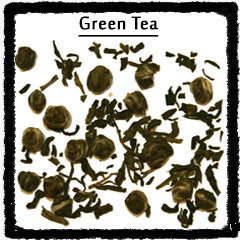Feeling Green
 Buddhist monks and traditional herbal healers have used green tea as a stimulant and medicinal drink for centuries. Its popularity is found in its ability to capture the essence of nature, containing high levels of micronutrients like chlorophyll. Brewed green tea lives up to its name with its vegetal, earthy flavor, and is often compared with fresh fruits and vegetables for its nutraceuticals. For much of tea’s long history, this green variety was the go-to, reliable choice for China and much of the world, but modern times have found black tea to be a fierce rival.
Buddhist monks and traditional herbal healers have used green tea as a stimulant and medicinal drink for centuries. Its popularity is found in its ability to capture the essence of nature, containing high levels of micronutrients like chlorophyll. Brewed green tea lives up to its name with its vegetal, earthy flavor, and is often compared with fresh fruits and vegetables for its nutraceuticals. For much of tea’s long history, this green variety was the go-to, reliable choice for China and much of the world, but modern times have found black tea to be a fierce rival.
Green tea has received praise for its high levels of the weight loss-related antioxidant compounds like epigallocatechin gallate (EGCG), which may also hold cancer-fighting properties. These compounds known as catechins found in tea leaves are simple to extract and use for pharmaceutical purposes and are continually being researched and refined. Please refer to the scientific studies at the bottom of this page for more information.
Green tea can also be found in a variety of products beyond brewed beverages and cafes, as its now available in many forms including ice cream, candy, and cosmetics.
These teas generally have a moderate amount of caffeine, less than black tea but more than white.
Energizing Power Hierarchy: White<Green<Oolong<Black<Coffee<Maté
Green Tea Caffeine Level: 15-20 mg per 6 oz. cup
Coffee Caffeine Level: 100-120 mg per 6 oz. cup
*Note: These caffeine levels are industry standard averages.
Production
Like white, oolong, and black teas, green tea is a product of the camellia sinensis plant. Green tea undergoes only a minor amount of processing to yield a gentle brew with vegetal and floral flavors.
Green tea undergoes four stages of production: withering, Chinese style pan frying or Japanese style steaming, rolling, and drying. The extent of each of these steps varies by region and producer preferences. The variation or alteration of each step can produce distinctly different tea flavors and textures.

Withering:
First, freshly picked leaves are left to wither for up 4 hours; however, shorter withering times are generally favored, as chlorophyll content decreases as time elapses.
Enzyme Kill:
Second, the tea leaves undergo one of two enzyme killing procedures: Chinese style pan frying or Japanese style steaming.
Chinese pan frying: The withered tea leaves are roasted by tossing the leaves in a dry, hot wok for 1-2 minutes.
Japanese steaming: The leaves are moved through a rolling, steaming tunnel for 60 seconds or less. This process produces green teas that are darker in color and allow more vitamins and nutrients to stay intact compared to pan frying.
Rolling:
Next, the leaves are rolled (shaped) into balls or needle-like shapes. This process is done by hand or, in some cases, by machine.
Drying:
Finally, the tea leaves are placed in a drying room/oven where they are dried until their water content has dropped to 3-6%.
Brewing:
The rule of thumb is to brew green tea at 180°F for 1-2 minutes; however, depending on the cut of the leaf and the level of processing, the brew time may be longer. For example, a rolled tea leaf like Eli Tea Jasmine Pearls requires 2-3 minutes to brew compared to Eli Tea Kyoto Sencha Rose Festival which only needs 1-2 minutes. This is partially because the Jasmine Pearls are rolled into pearl-balls, thus requiring additional time to unfold.
Health Benefits
Good diuretic
Boost metabolism
Cancer-fighting compounds
Antibacterial properties
Antioxidants
Trending Scientific Research:
Cancer prevention by tea: animal studies, molecular mechanisms and human relevance



Thomas
December 02, 2015
I like your post. It’s very informative to me. Thanks for sharing.
Green tea is a healthy drink and rich in Flavonoid antioxidants. It helps in Weight loss, Type 2 diabetes prevention, prostate cancer prevention, breast cancer prevention, lung cancer prevention, or gingivitis. . It has 30 mg of caffeine per serving.
View Enjoying Tea and you can get more amazing information.